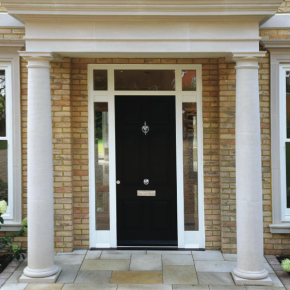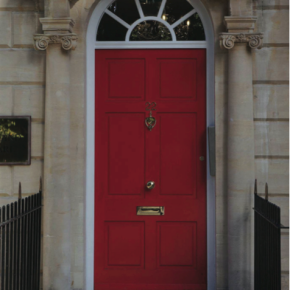
Be safe, sound and secure behind a timber door
Mumford & Wood explains the benefits of home-produced timber entrance doors in the latest issue of ABC+D magazine…
Most of the oldest buildings in the country, those that we have all admired and enjoyed – from castles and palaces, to places of learning, prayer, contemplation and recovery – have magnificent doors made from timber.
Today these national treasures, protected and cosseted with the help of private trusts, public ownership and a stream of funding to support regular maintenance, look every bit as imposing as they did when they were crafted.
This cannot be said of cheap imports, mainly from the Far East, that were much needed to support the explosion of property ownership in the 1960s through to recent times. For those who did – and can still – purchase their local authority house at a fine discount, ownership encouraged investment in new doors and windows.
The market research carried out by the British woodworking industry in the late 1970s, when Taiwanese imports were at their highest level, identified that UK home owners typically paid an average of £50 for a new front door – a stark difference to their West German counterparts who would pay in the region of £3,000.
“This prompted an industry-funded campaign: What a Difference a Door Makes, aimed at the private homeowner to invest in a new timber entrance door, made in the UK,” explains Roy Wakeman, CEO, The Performance Timber Products Group.
“The campaign was hugely successful and, while it didn’t see off all the cheap imports, the consumer became educated about the benefits of a home-produced timber door and was willing to spend more. By the mid ‘80s the market peaked at 3m units and had a value of £400m.”
Inevitably the bubble burst, brought about by the plastic revolution and campaigns selling the virtues of double glazed fenestration with low pricing and so-called authentic, classic design. By 2000, the timber market share was lost in windows alone, by some 80%, in favour of plastic. Timber doors, however, retained a higher share as the consumer was still attracted to the greater security of timber and its performance.

“Current research suggests that the major driving force for home owners when purchasing new doors and windows is security and energy conservation” Roy Wakeman
More recently, the industry has seen the rise of composite door constructions where modern materials have been used to make up the door core; this has then been covered with an external finish of thermal plastic; glass-reinforced plastic, (GRP); and even wood fibre-based boards.
These products have performed and today account for more than half of the UK market, now measured at £600m with growth of more than 5% per annum.
Security and robustness has been achieved by the strength of the door core together with good ironmongery. Today, this will contain espagnolette systems that can lock all three leading edges, using shoot bolts or hooks, with a central controlling arm handle.
A national standard for security has existed, along with test methodology to BS 7950, which values security, thermal performance and weather resistance to regional degrees of exposure.
Secured by Design, a police-recommended standard and marketing tool for the private housebuilding sector, has prevailed for more than 30 years and is frequently a standard requested by designers, architects and developers responsible for new developments.
Only last year the new Approved Document Q Building Regulation was introduced for the new build sector which demands even greater security standards for doors and windows. The security standard demanded by Building Regulations, to which products are tested, is known as PAS 24 but, prior to this, all products must be tested and rated for weather and air tightness to meet BS 6375 (Parts 1 & 2).
“While the requirement to meet Document Q applies to new buildings only, existing home owners will want these security benefits applied to replacement products for the upkeep and maintenance of their properties as well as for major refurbishments and extensions,” says Roy Wakeman.
“Current research suggests that the major driving force for home owners when purchasing new doors and windows is security and energy conservation.
“It comes as no surprise that the timber door, complete with all the appropriate ironmongery, factory-assembled and finished, is now leading the way again to dominate the choice for new door designs and mechanics that more than satisfy today’s demanding standards.”
Timber is the most versatile of all materials and can be easily finished with modern, water-based paints or stains, chosen from a huge range of colours and shades. These modern finishes now come with lifetime warranties for the complete door set, with maintenance cycles at a very minimum, while the paint itself is expected to last up to eight years before redecoration is needed.
Composite door cores, using urea or phenolic forms, are not exactly the best products to satisfy today’s demanding consumer who knows all about active carcinogens and the toxicity of chemically-based products.
For complete peace of mind, it is far better to use a sustainable and naturally- replacing material, such as timber, to ensure that our children’s children grow up in a safe, sound and comfortable environment behind modern timber windows and doors.
Modern timber engineering techniques and water-based, friendly finishing treatments, do make timber the material with the very greenest credentials.
Latest news

19th April 2024
ASSA ABLOY: Access solutions can impact sustainability performance across the full life-cycle of a building
Embedding sustainability within any organisation requires a broad, strategic perspective. Scrutiny should include the physical infrastructure itself: According to the IEA, buildings consume around 30% of global energy*. ASSA ABLOY has more…
Posted in Access Control & Door Entry Systems, Architectural Ironmongery, Articles, Building Industry News, Building Products & Structures, Building Regulations & Accreditations, Building Services, Case Studies, Doors, Facility Management & Building Services, Information Technology, Research & Materials Testing, Retrofit & Renovation, Security and Fire Protection, Sustainability & Energy Efficiency, Video of the Week
19th April 2024
British weather doesn't dampen spirit for new HMG Garden Paint
Despite one of the wettest starts to the year on record, customers are starting to plan for brighter days with HydroPro Garden Paint from HMG Paints.
Posted in Articles, Building Industry News, Building Products & Structures, Garden, Innovations & New Products, Paints, Paints, Coatings & Finishes, Restoration & Refurbishment, Retrofit & Renovation, Site Preparation, Sustainability & Energy Efficiency, Waste Management & Recycling
18th April 2024
Abloy UK showcases new digital portfolio at The Security Event 2024
Abloy UK is set to unveil its latest line-up of access control systems at The Security Event 2024, welcoming guests to explore its cutting-edge electromechanical and digital solutions on stand 5/F50.
Posted in Access Control & Door Entry Systems, Architectural Ironmongery, Articles, Building Industry Events, Building Industry News, Building Products & Structures, Building Services, Doors, Exhibitions and Conferences, Facility Management & Building Services, Health & Safety, Information Technology, Retrofit & Renovation, Security and Fire Protection
18th April 2024
Strand is a Failsafe Choice for Emergency Exit and Panic Hardware
In times of emergency, you’re in safe hands with Strand Hardware. Although there are many considerations for building specification, few decisions can be as critical as selecting the right emergency exit/panic hardware.
Posted in Access Control & Door Entry Systems, Architectural Ironmongery, Articles, Building Industry News, Building Products & Structures, Building Services, Doors, Facility Management & Building Services, Health & Safety, Restoration & Refurbishment, Retrofit & Renovation, Security and Fire Protection
 Sign up:
Sign up: